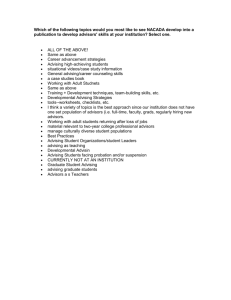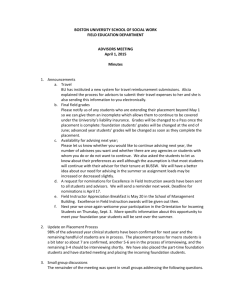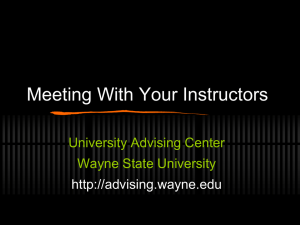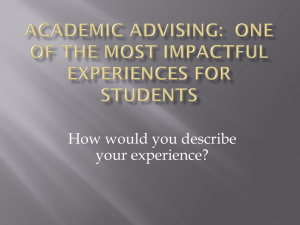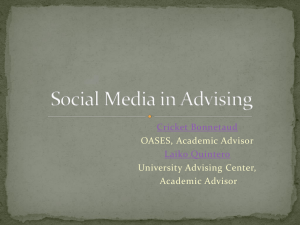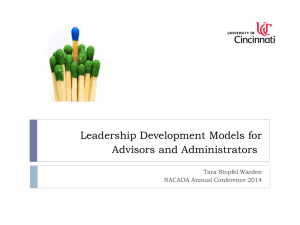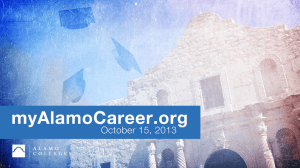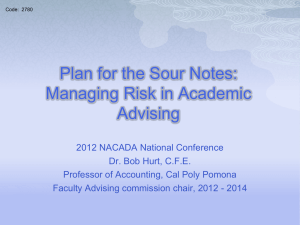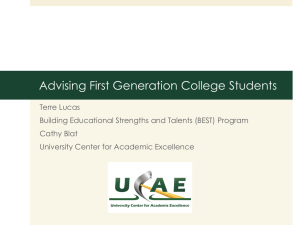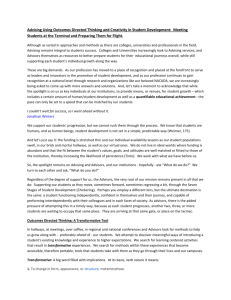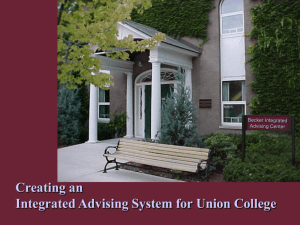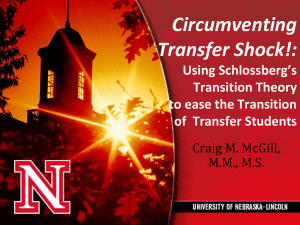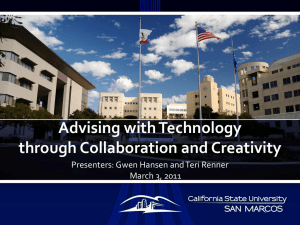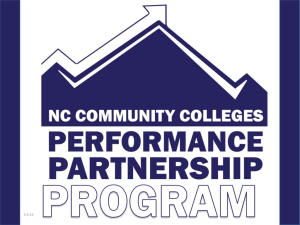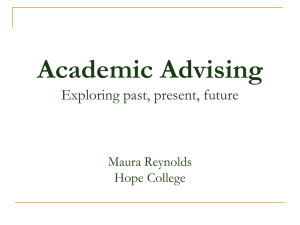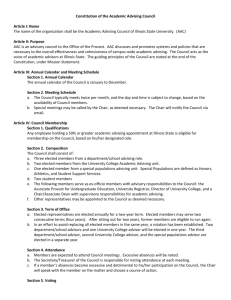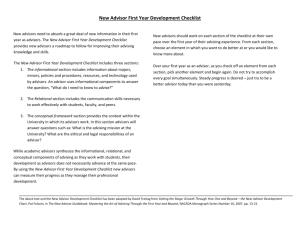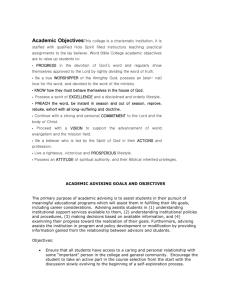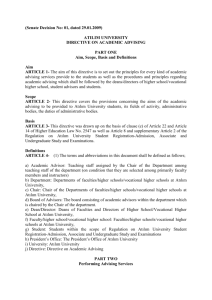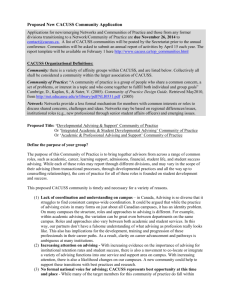Presentation Materials (PPT File)
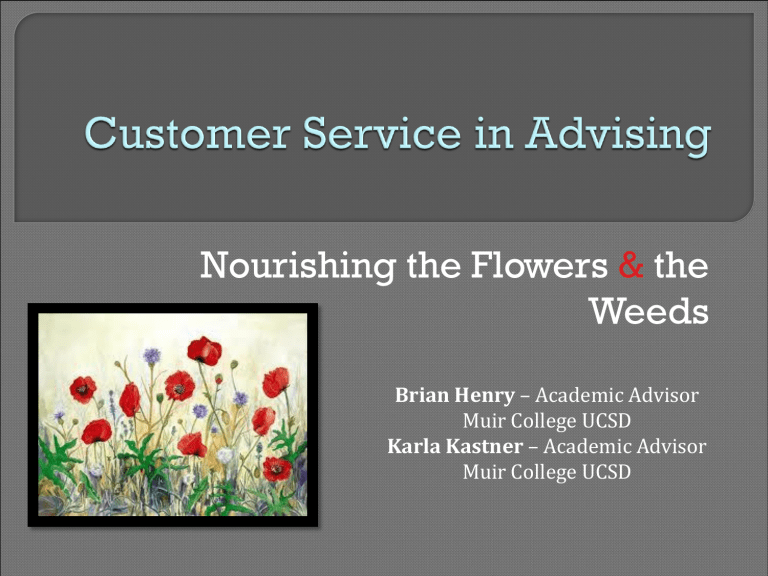
Nourishing the Flowers & the
Weeds
Brian Henry – Academic Advisor
Muir College UCSD
Karla Kastner – Academic Advisor
Muir College UCSD
Think of a time when you experienced excellent customer service. . .what did that experience look like? How did it make you feel? Why was it special or meaningful?
Think of a time when you experienced the worst customer service. . . what did that experience look like? How did you feel afterward? What made it a negative moment?
Student expectations shaped by consumer driven society.
Entitlement when see tuition as paying for services/education.
As advisors we can employ customer service best practices to shape our interactions with our students and create more quality outcomes for both students and advisors.
Different Models
•
•
•
Disney-Welcoming and Setting the Stage
Nordstrom-Personalized Service and Innovation
Healthcare-Service Recovery and Evaluation
Implications for Advising
“We keep moving forward , opening new doors, and doing new things, because we’re curious and curiosity keeps leading us down new paths.” – Walt Disney
Greeting & welcoming
Setting the stage – cast members in a show
Take advantage of every opportunity – magical express.
“What time is the 3pm parade?”: never make guests feel like a question is silly.
We mentality: we all take responsibility
It’s about the whole experience
Creating a show
• Group advising series marketed specifically to incoming freshman.
Welcoming guests & answering questions
• Frustration about decentralized campus: by holding hand a little bit and explaining why we’re referring out can feel more personal and less like being turned away.
In-between opportunities
• Passive programming: use the waiting area, website, Facebook.
“Nordstrom Rule #1: Use your good judgment in all situations.
There will be no additional rules.” – Nordstrom Employee Handbook .
Use your good judgment
Follow-through: make them come back!
Innovation
Creativity
Initiative
Establish rapport with the customer
Goal setting essential to company culture
Initiative
• Give student all information relating to a question including what they aren’t asking.
• Avoids “you never told me.”
Follow-through
• Advising students on academic probation: ask them to follow-up before week 4 & 9 deadlines. Always surprised that we want to see them more than once—translation: I care.
Creativity/Innovation
• Share best practice ideas & trends with coworkers to meet changing demands.
“The way an organization seeks complaints and service failures sends a loud message about what it truly believes in.”
Service Recovery
The Six A’s
“Poka-yokes”
Employee-Driven Strategies
Evaluation and Systematic Change
Feedback
• Create opportunities for feedback during and after meeting with students.
Take Responsibility
•
•
Proactively “mistake-proof” your department and anticipate problems.
• Model responsibility for our students and be accountable for mistakes.
Change and Improve
Once mistakes are identified, use them an opportunity. Work not only with your department, but the larger university as well.
Using these customer service techniques can be the antidote to the entitled student & empower the advisor.
• Creating an experience leading to trust promotes student “buy in” and allows us to advance our advising goals.
Create Loyalty and Identity
• Why as a form of action
Barriers: too much time/work
• We all feels pressures of stress (high volume of students/not enough resources), but in the end we are professionals who are passionate about education and maybe by working within the frame work of student expectation we can create the change we want to see.
As advisors, we are the public faces of our universities and have the power to help students understand how to utilize our services & shape expectations of what advising is.
Bell, Steven J. "Antidote for Entitled 'Customers' | Inside Higher Ed." Antidote
for Entitled 'Customers' | Inside Higher Ed. 29 July 2011. Web. 31
May 2012.
<http://www.insidehighered.com/views/2011/07/29/bell_essay_on
_changing_ clasroom_experience_to_meet_student_demands>.
Clark, Paul Alexander, and Mary P. Malone. Making It Right:Healthcare Service
Recovery Tools, Techniques, and Best Practices. Marblehead, MA:
HCPro, 2005. Print.
Elizard, Brian J. "6 Things Disney Can Teach Us About Academic Advising."
Elizardi Dot Com. Web. 30 May 2012.
<http://elizardi.com/blog/2011/01/24/6-things-disney-can-teachus-about-academic-advising/>.
Fottler, Myron D., Robert C. Ford, and Cherrill P. Heaton. "Fixing Healthcare
Service Failures." Achieving Service Excellence: Strategies for
Healthcare. Chicago: Health Administration, 2010. Print.
Payne, Kirby J. "What Time Is the 3PM Parade? (Should Your Hotel Have a
Some Mickey Mouse(r) in It?) / Kirby D. Payne, CHA." What Time
Is the 3PM Parade? (Should Your Hotel Have a Some Mickey Mouse(r)
in It?) / Kirby D. Payne, CHA.Web. 31 May 2012. <http://www.hotel
online.com/Trends/Payne/Articles/WhatTimeParade.html>.
Spector, Robert, and Patrick D. McCarthy. The Nordstrom Way: The inside
Story of America's # 1 Customer Service Company. New York: Wiley,
1995. Print.

